The 7-spot ladybird, Coccinella septempunctata, is the archetypal ladybird. Featured in toys, games and company logos, this is one of the very few insect species with a positive public image - in fact, it's nicknamed 'the gardener's friend' for its habit of devouring pest insects such as aphids.
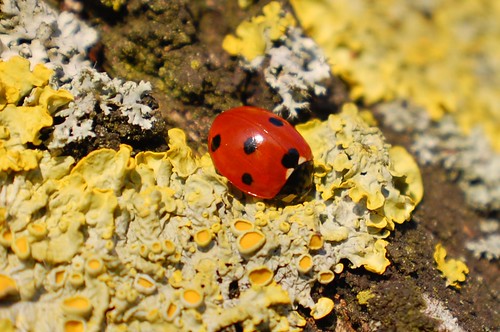
An adult 7-spot ladybird, sunbathing to warm up
The adults are amongst the easiest insects to identify - big (5-8mm long) and bright orange, they make no effort to hide (their bright colours are a warning to predators of their foul taste), and they only come in one colour form, unlike species such as the 2-spot or Harlequin ladybirds (the snowflakes of the insect world, with no two individuals alike).
99.9% of the 7-spots you'll ever see will look almost exactly like the one pictured above - the wing cases (elytra) a bright orange/red, with a pyramid of three roundish black spots on each, and a 7th stretched across both elytra at the front, just behind the black-and-white head and thorax. Occasionally specimens miss spots, or have tiny extra ones, but in general, the picture is what they'll look like.
As a double-check, the 7-spot is one of the largest ladybirds in Britain - most of our 47 species are less than 5mm long. The only species which can look similar, and is a similar size, is the Harlequin (Harmonia axyridis), which can sometimes have very few spots, but the orange colour form of the Harlequin always has a black 'M' on the thorax, which is never present in the 7-spot.
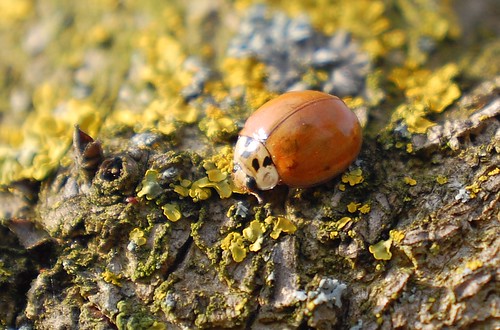
Definitely not a 7-spot ladybird. The spotless form of the Harlequin ladybird - note the 'M' marking
Ladybirds, like most insects, have the 4-stage life cycle familiar from butterflies - egg, larva, pupa, adult. In butterflies and moths the stages can have different names - caterpillar for the larva and chrysalis for the pupa, for example - but with ladybirds, it's just egg, larva, pupa, adult. Although not as easy as the adult, it's still entirely possible to successfully identify pupae and fully-grown larvae of the 7-spot.
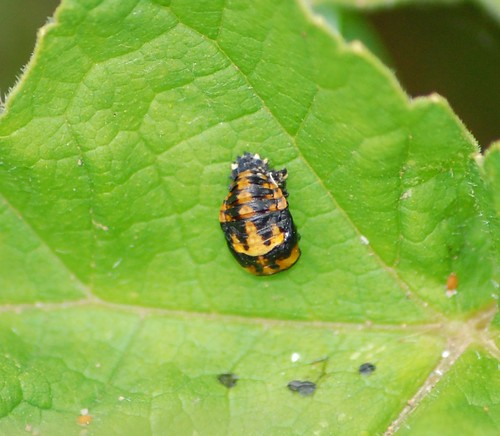
Pupa of a 7-spot ladybird
A lot of people will have seen a ladybird pupa without realising what the strange, blob-like creature on the leaf actually was, and it's true, they do look a bit odd - especially when they feel threatened and rear up and down like a globular hinge! Only found in the vicinity of aphids, 7-spot pupae are rounded, orange-and-black, and big enough to fit an adult ladybird inside them (again, much larger than most of the other ladybird species), and with the shed skin of the larva at the back end, where it's attached to the leaf. The shed skin is an important feature for distinguishing 7-spot pupae from Harlequins, which are brighter orange and have a very spiky shed larval skin.

Not a 7-spot. A Harlequin ladybird pupa, note the brighter orange and obvious spines on the shed larval skin
The combination of size and lack of spines is a good pointer for the larvae, too. Again, they're big, and covered in warts (not spines), and they have a couple of orange flashes on either side, each made up of two warts, one on top of the other. There are a few fairly similar species, but none of them have the combination of large size and the 4 orange patches. They have a voracious appetite for aphids, and you won't find them far from an aphid colony (or underneath one).
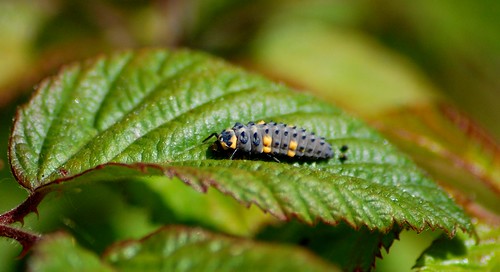
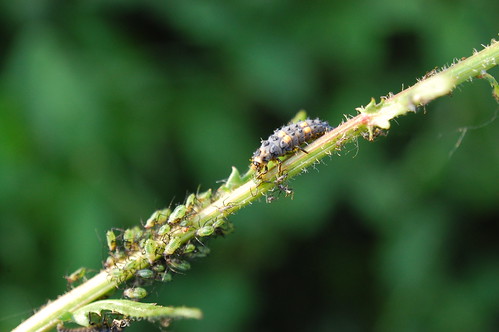
Two views of 7-spot ladybird larvae
Any ladybirds you see should be recorded at the UK Ladybird Survey website (http://www.ladybird-survey.org/), which is also well worth looking at for the other species, and for lots more information besides. There are also plenty of ladybird photos on the web - my Flickr sets are below:
Adult ladybirds - http://www.flickr.com/photos/rcomont/sets/72157623774877905/
If you prefer paper, the Field Studies Council also publish ID charts for the ID of adult (http://www.field-studies-council.org/publications/pubs/guide-to-ladybirds-of-the-british-isles.aspx) and larval ladybirds (http://www.field-studies-council.org/publications/pubs/ladybird-larvae.aspx)
And of course, don't forget to join in with the Garden Bioblitz on the 1st/2nd June 2013! http://www.naturewatched.org/gbb.html for more details